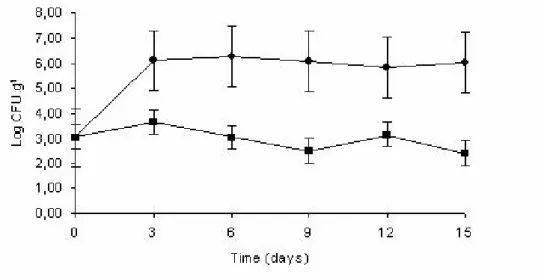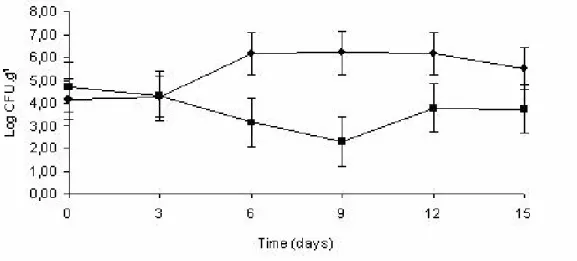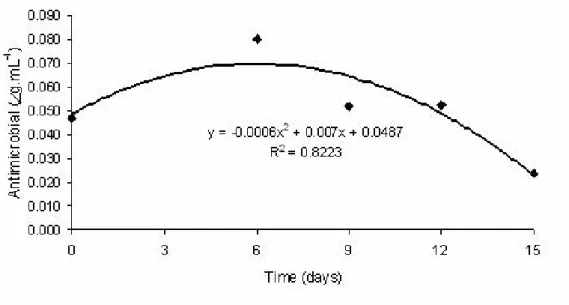INCREASED PRESERVATION OF SLICED MOZZARELLA CHEESE BY ANTIMICROBIAL SACHET INCORPORATED WITH ALLYL ISOTHIOCYANATE
Ana Clarissa dos Santos Pires1, Nilda de Fátima Ferreira Soares*1, Nélio José de Andrade1, Luis Henrique Mendes da Silva2, Geany Peruch Camilloto1, Patrícia Campos Bernardes1
1
Departamento de Tecnologia de Alimentos, Universidade Federal de Viçosa, Viçosa, MG, Brasil; 2 Departamento de
Química, Universidade Federal de Viçosa, Viçosa, MG, Brasil.
Submitted: March 25, 2008; Returned to authors for corrections: June 29, 2008; Approved: July 27, 2009.
ABSTRACT
There is an increasing tendency to add natural antimicrobials of plant origin into food. The objective of
this work was to develop a microbial sachet incorporated with allyl isothiocyanate (AIT), a volatile
compound of plant origin, and to test its efficiency against growth of yeasts and molds, Staphylococcus sp.
and psychrotrophic bacteria on sliced mozzarella cheese. Another objective was to quantify the
concentration of AIT in the headspace of cheese packaging. A reduction of 3.6 log cycles was observed in
yeasts and molds counts in the mozzarella packed with the antimicrobial sachet over 15-day storage time.
The sachet also showed an antibacterial effect on Staphylococcus sp., reducing 2.4 log cycles after 12-day
storage. Psychrotrophicbacteria species were the most resistant to the antimicrobial action. The highest
concentration of AIT (0.08µg.mL-1) inside the active packaging system was observed at the 6-day of
storage at 12 ºC ± 2 ºC. At the end of the storage time, AIT concentration decreased to only 10% of the
initial concentration. Active packaging containing antimicrobial sachet has a potential use for sliced
mozzarella, with molds and yeasts being the most sensitive to the antimicrobial effects.
Key words: antimicrobial sachet, Mozzarella cheese, food protection, allyl isothiocyanate
INTRODUCTION
Antimicrobial packaging can eliminate or inhibit the
growth of spoilage and pathogenic microorganisms. The
basic principle of this type of packaging is to be added of a
microbiological barrier besides the physical barriers to
oxygen and moisture (6). It has been suggested that
antimicrobial agents could be incorporated into food
packaging systems to create an environment which will
maintain their activity during food storage (14). According to
Santiago-Silva et al. (19), some of the antimicrobial system
includes the addition of sachets containing volatile
antimicrobial agents into the packages, application of edible
coatings with the antimicrobial component, and the
incorporation of antimicrobial agents directly to the package
material.
Several studies have shown the efficiency and
applicability of antimicrobial packaging, including those
incorporated with natural antimicrobials. In the last 20 years,
hundreds of laboratories studies have shown microbial
activity of natural compounds against spoilage and
pathogenic microorganisms (18).
The addition of natural antimicrobials of plant origin into
foods is an increasing practice. Natural extracts and essential
oils have long been utilized to extend shelf life and the
sensory quality of foods (6).
Some plants, their extracts or active principles have
shown antimicrobial activity in laboratory studies. Spices and
herbs have different levels of biological activity; however,
their effectiveness against microorganisms occurs at very
high concentrations (16). On the other hand, studies have
shown that some antimicrobials of plant origin are capable of
inhibiting a variety of pathogens, even at low concentrations
(5).
Studies show the efficiency of volatile antimicrobials
against several microorganisms in a culture medium. Nielsen
and Rios (15) studied the effect of six different essential oils
on six types of molds in Czapek agar and observed that only
mustard oil was capable of inhibiting the growth of all the
microorganisms tested, including Aspergillus flavus, during
seven days of incubation.
Other works have shown the efficiency of these
antimicrobials of plant origin against some microorganisms
in foods. Mustard oil at a concentration of 20 % was effective
in reducing to non-detectable levels of Escherichia coli
O157:H7 after three days of storage at 4 ºC (12). The use of a
packaging system containing antimicrobials of volatile plant
origin reduced 3 log cycles in E. coli O157:H7 count in
ground beef stored at –18 ºC (13). Allyl isothiocyanate was
also effective against E. coli O157:H7 present in chopped
beef (4).
Allyl isothiocyanate in cooked rice packed in high gas
barrier packaging material was efficient in reducing 3 log
cycles of total mesophilic aerobic microorganisms after 12
hour storage at 25 ºC (8). Delaquis et al. (5) observed that
horseradish essential oil presented antibacterial action mainly
against Pseudomonas sp. and enteric bacteria, while acid
lactic bacteria were little affected.
According to Delaquis et al. (5), volatile antimicrobials
are more effective when used in closed atmosphere systems
that would allow volatilization of the compound and its
permanence inside the packaging. Thus, the use of packaging
with a lower rate of permeability to gases is recommended.
Cheese is a type of food frequently involved in outbreaks
of foodborne bacterial diseases (3). Consuming refrigerated
sliced food is a common Brazilian habit. The product may be
contaminated during slicing if the hygiene conditions of the
equipment surfaces are inadequate. One of the major risk
factors in the transmission of diseases by food is
cross-contamination between food and food contact surfaces (9).
Within this context, this work aimed to develop a sachet
containing a volatile antimicrobial of mustard plant origin, to
evaluate its antimicrobial efficiency against yeasts and molds,
Staphylococcus sp. and psychrotrophic bacteria in sliced
mozzarella cheese as well as to quantify the antimicrobial
compound present in the cheese packaging.
MATERIAL AND METHODS
Production of antimicrobial sachet
The antimicrobial sachets (PI0603881-6) (21) were
produced adding allyl isothiocyanate (AIT) (94 mg.100 mg-1)
to a high absorption polymeric resin (Accurel® XP200,
HDPE, Accurel Systems International Corp., Sunnyvale,
California, USA). The sachets were prepared with 1 mg.100
mg-1 of AIT over the resin weight. After the entire absorption
of the AIT by the porous resin, the antimicrobial system was
placed in non-tissue sachets, which were hot sealed.
Antimicrobial efficiency of sachet in sliced mozzarella cheese
Sliced mozzarella cheese was purchased in the local
market. Mozzarella slices without preservative were
separated by low density polyethylene films (LDPE) and
placed in PE/NYLON bags (Cryovac Division, Sealed Air
Corporation, Duncan, SC, USA), selected based on its low
shown that the oxygen transmission rate for PE/NYLON
films is 2.45 %O2/m 2
/day.
Two antimicrobial sachets were fixed inside these bags
with the help of a double-face tape. The packaging materials
were sealed and stored at 12 ºC ± 2 ºC, simulating abusive
temperature during transport or storage of the product. The
cheese slices were analyzed at 0, 3, 6, 9, 12 and 15 days of
storage. Control consisted of packaging without the
antimicrobial sachet.
Microbiological analyses
The cheese slices were submitted to counts of
Staphylococcus sp., yeasts and molds and psychrotrophic
bacteria in each storage time.
A 25 g mozzarella slice was aseptically sampled and
added to 225 mL of sodium citrate at 2%. The mixture was
homogenized for 1 minute in Stomacher ITR, model 1240.
Serial dilutions and aliquots of 0.1 mL were inoculated onto
Baird-Parker agar surface (Difco®, Becton, Dickinson and
Company, Franklin Lakes, New Jersey, USA), BDA (Difco®)
and PCA (Difco®), for enumeration of Staphylococcus sp.,
yeasts and molds and psychrotrophic bacteria, respectively.
The plateswere incubated at 35 ºC ± 2 ºC for 24 – 48 h for
Staphylococcus sp. , at 23 ºC ± 2 ºC over 3 to 5 days for
yeasts and molds and at 7 ºC ± 2 ºC over 7 to 10 days for
psychrotrophic bacteria. Plates containing 25 to 250 colonies
were selected for counting (1). The results were expressed in
UFC.g-1.
Quantification of the volatile antimicrobial headspace packaging
The packaging materials were analyzed at 0, 6, 9, 12 and
15 days of storage. Aliquots of 100 µL of the air contained in
the packaging were used for quantification of the
antimicrobial compound in a gas chromatograph mass
spectrometer (GC-MS).
Analysis was conducted in a Shimadzu chromatograph,
model GCMS-QP5050, column DB5 (0.25 mm i.d. x 30 m,
0.25 µm thick, Shimadzu Co., Kyoto, Japan). The GC oven
temperature increased at 8 ºC.min-1 from 50 ºC to 70 ºC,
which was maintained for 5 minutes, followed by a new
increase from 70 ºC to 78 ºC at a rate of 2 ºC.min-1, which
was also maintained for 5 minutes. Finally, there was a new
heat increase from 78 ºC to 250 ºC at a rate of 10 ºC.min-1,
with the total run time of 38.7 minutes. Helium (1 mL.min-1,
split ratio of1:10) was used as carrier gas.
For AIT quantification, a standard curve with different
known concentrations of the antimicrobial was obtained,with
a retention time of 7.125 minutes.
Statistical analysis
The experiment was conducted in three repetitions,
arranged in a randomized block design, in a factorial
experiment with time and sachet being the factors studied.
The decimal logarithms of the microbial counts were
submitted to analysis of variance, at 5% of probability level,
and adequately analyzed by the Tukey test, or variance
regression, as applied.
For quantification of AIT, the experiment was carried out
in three repetitions, in a completely randomized block design.
The compound concentrations, expressed in µg.mL-1, were
submitted to analysis of variance and analyzed by linear
regression.
The statistical analyses were carried out with the help of
the program Statistical Analysis System (SAS), version 9.0.
RESULTS AND DISCUSSION
Antimicrobial efficiency of the sachet in sliced mozzarella cheese
The initial count of yeasts and molds in the sliced
mozzarella was 3.02 log CFU.g-1. Although the Brazilian
legislation has not established limits for these groups of
microorganisms in mozzarella, they are frequently involved
in the deterioration of cheese, especially sliced cheese. The
mold growth causes alterations in the coloration and flavor of
the product and there is the possibility of mycotoxin
The antimicrobial sachet was capable of inhibiting
(p<0.05) the growth of yeasts and molds throughout storage
time (Figure 1). Comparing the counts in the control sample
and the antimicrobial-treated sample, a difference of 3.6 log
cycles was observed after 15 storage days at 12 ºC ± 2 ºC.
Another study, conducted by Pires et al. (17) achieved a
reduction of 2.0 log cycles for yeasts and molds counts in
sliced mozzarella. These results show the broad antimicrobial
effect of AIT against this group of microorganisms.
The initial counts of Staphylococcus sp. were high (4.45
CFU.g-1). The colonies were Gram-positive but typical
coagulase-positive Staphylococcus sp. were not found, what
meets the Brazilian legislations, which proposes standards
only for coagulase-positive Staphylococcus sp.. However,
studies have shown that coagulase-negative Staphylococcus
sp. can be involved in food poisoning outbreaks. Research
carried out by Vernozy-Rozand et al. (22) verified that 5.3 %
of the 187 coagulase-negative Staphylococcus sp. strains
isolated from goat’s milk and cheese produced enterotoxin.
Pools of coagulase-negative Staphylococcus sp. isolated from
Canastra cheese samples were positive for production of
enterotoxin B, C and D, and TSST-1 toxin (2). Carmo et al.
(3) also showed the presence of these microorganisms in milk
responsible for food poisoning outbreak in Minas Gerais,
Brazil.
Figure 1. Effect of the antimicrobial sachet on the growth of yeasts and mold in sliced mozzarella cheese: ( ) Packaging without sachet ( ) Packaging with antimicrobial sachets.
Up to the three days of storage, Staphylococcus sp.
counts in treated and non-treated samples presented no
difference (p 0.05) (Figure 2). From the 6-day until the
12-day of storage, the count of these microorganisms in the
packaged samples containing sachets was lower (p<0.05)
than in the control sample, indicating their efficiency against
Staphylococcus sp. On the 9-day, the difference in counts in
the treated and non-treated samples was 4 log cycles. At the
end of the storage time (15 days), means of the treated and
non-treated samples did not differ (p 0.05). However, the
counts at the end of the storage time (15 days) did not differ
significantly in the two types of samples.
The initial psychrotrophic bacteria count was 4.64 log
CFU.g-1. This group of microorganisms causes several
problems in the dairy industry due to production of heat
resistant proteases and lipases which alter the texture, flavor,
and yield of the cheese. At 9 and 15 days of storage, a
significant difference (p<0.05) in counts of psychrotrophic
bacteria in treated and the non treated samples was observed
1.7 log cycles; however, on the 15th day, the difference was
less than a 1 log cycle.
It was also observed that when the antimicrobial
treated-cheese samples were plated out, the colonies formed on the
different media used for enumeration were smaller than those
originated from the non-treated samples, indicating that the
volatile antimicrobial may have caused injury to the cells.
Similar results were also observed by Lin et al. (11).
Figure 2. Effect of antimicrobial sachet on the growth of Staphylococcus sp. in sliced mozzarella cheese: ( ) Packaging without sachet ( ) Packaging with antimicrobial sachet.
Figure 3. Effect of the antimicrobial sachet on the growth of psychrotrophic bacteria in sliced mozzarella cheese: ( ) Packaging without sachet ( ) Packaging with antimicrobial sachet.
Quantification of the volatile antimicrobial in the free space of the packaging
The amount of volatile antimicrobial present in the
packaging headspace varied significantly (p<0.05) along the
storage (Figure 4). Based on the amount of antimicrobial
incorporated into the resin and on the amount that volatized
into packaging headspace, the theoretical antimicrobial
of storage, the maximum antimicrobial amount was reduced
to 0.08 g.mL-1 and decreased to only 0.02 g.mL-1 on the
15th day of storage at 12ºC ± 2ºC, probably due to the
antimicrobial interaction with lipids (7, 12,13) and groups
such as thiols, sulphydryls, free amino acids, and protein
disulphides(8). Reduced volatile antimicrobial concentration
may also have occurred due to antimicrobial interaction with
the resin, as well as its adsorption and permeation through the
packaging material (10). Nadarajah et al. (12) added 0.5 mL
and 1.0 mL corn oil containing 70 % of volatile antimicrobial
of plant origin in filter paper into an active packaging system
for ground beef and observed that after two days of storage at
10ºC, 95 % of the initial concentration of 1.33 g.mL-1 was
maintained.
Figure 4. Concentration of allyl isothiocyanate inside the packaging during the mozzarella cheese storage period.
In conclusion, the active packaging system containing
allyl isothiocyanate has a great potential to be applied in
cheese for inhibition of the growth of deteriorating and
potentially pathogenic microorganisms, such as
Staphylococcus sp., frequently involved in poisoning
outbreaks.
ACKNOWLEDGEMENTS
The authors are grateful to CAPES, CNPq, FAPEMIG
and FINEP for financial support.
REFERENCES
1. APHA - American Public Health Association. (2001). Compendium of Methods for the Microbiological Examination of Foods, 4th ed. American Public Health Association, Washington, DC, USA.
2. Borelli, B.M.; Ferreira, E.G.; Lacerda, I.C.A.; Santos, D.A.; Carmo, L.S.; Dias, R.S.; Silva, M.C.C.; Rosa, C.A. (2006). Enterotoxigenic Staphylococcus spp. and other microbial contaminants during production of Canastra cheese, Brazil. Braz. J. Microbiol, 37 (4), 545-550.
3. Carmo, L.S.; Dias, R.S.; Linardi, V.R.; Sena, M.J.; Santos, D.A.; Faria, M.E.; Pena, E.C.; Jett, M.; Heneine, L.G. (2002). Food poisoning due to enterotoxigenic strains of Staphylococcus present in Minas cheese and raw milk in Brazil. Food Microbiol. 19 (1), 9-14.
4. Chacon, P.A.; Buffo, R.A.; Holley, R. A. (2006). Inhibitory effects of microencapsulated allyl isothiocyanate (AIT) against Escherichia coli O157:H7 in refrigerated, nitrogen packed, finely chopped beef. Int. J. Food Microbiol., 107(3), 231 – 237.
5. Delaquis, P.J.; Ward, S.M.; Holley, R.A.; Cliff, M.C.; Mazza, G. (1999). Microbiological, chemical and sensory properties of pre-cooked roast beef preserved with horseradish essential oil. J.Food Sci. 64 (3), 519-524.
USA, p. 50-65.
7. Isshiki, K.; Tokuoka, K.; Mori, R.; Chiba, S. (1992). Preliminary examination of allyl isothiocyanate vapor for food preservation. Bios.Biotechnol.Bioch. 56 (9), 1476-1477.
8. Kim, Y.S.; Ahn, E.S.; Shin, D.H. (2002). Extension of shelf life by treatment with allyl isothiocyanate in combination with acetic acid on cooked rice. J.Food Sci. 67 (1), 274-279.
9. Legnani, P.; Leoni, E.; Berveglieri, M.; Mirolo, G.; Alvaro, N. (2004). Hygienic control of mass catering establishments, microbiological monitoring of food and equipment. F. Control 15 (3), 205-211. 10. Lim, L.T.; Tung, M.A. (1997). Vapor pressure of allyl-isothiocyanate
and its transport in PVDC/PVC copolymer packaging film. J.Food Sci. 62 (5), 1061-1067.
11. Lin, C.M.; Preston, J.F.; Wei, C. (2000). Antibacterial mechanism of allyl isothiocyanate. J.Food Prot. 63 (6), 727-734.
12. Nadarajah, D.; Han, J.H.; Holley, R.A. (2005). Inactivation of Escherichia coli O157:H7 in package ground beef by allyl isothiocyanate. Int.J.Food Microbiol. 99 (3), 269-279.
13. Nadarajah, D.; Han, J.H.; Holley, R.A. (2005). Use of mustard flour to inactivate Escherichia coli O157:H7 in ground beef under nitrogen flushed packaging. Int.J.Food Microbiol 99 (3), 257-267.
14. Nguyen, V.T.; Gidley, M.J.; Dykesc, G.A. (2008). Potential of a nisin-containing bacterial cellulose film to inhibit Listeria monocytogenes on processed meats. Food Microbiol., 25(3), 471–478.
15. Nielsen, P.V.; Rios, R. (2000). Inhibition of fungal growth on bread by volatile components from spices and herbs, and the possible application in active packaging, with special emphasis on mustard essential oil.
Int.J.Food Microbiol 60 (2-3), 219-229.
16. Nychas, G.J.E.; Skandamis, P.N. (2003). Antimicrobials from herbs and spices. In: Roller, S. (Ed.) Natural Antimicrobials for the Minimal Processing of Foods, Woodhead Publishing Limited, Cambridge, England, p.177-201.
17. Pires, A.C.S.; Soares, N.F.F.; Andrade, N.J.; Silva, L.H.M.; Camilloto, G.P.; Bernardes, P.C. (2008). Development and evaluation of active packaging for sliced Mozzarella preservation. Packag. Technol. Sci., 21(7), 375-383.
18. Roller, S. (2003). Introduction. In: Roller, S. (ed.) Natural Antimicrobials for the Minimal Processing of Foods, Woodhead Publishing Limited, Cambridge, England, p. 1-10.
19. Santiago-Silva, P.; Soares, N.F.S.; Nobrega, J.E.; Junior, M.A.W.; Barbosa, K.B.F.; Volp, A.C.P.; Zerdas, E.R.M.A.; Wurlitzer, N.J. (2009). Antimicrobial efficiency of film incorporated with pediocin (ALTA_ 2351) on preservation of sliced ham. F. Control, 20(1), 85-89. 20. Silva, W.A. (2008). Desenvolvimento e avaliação de embalagens ativas
para a melhoria da segurança alimentar de amendoim (Arachis
hipogaea L.). Viçosa, Brasil, 64p. (D.Sc. Thesis. Departamento de Tecnologia de Alimentos. UFV).
21. Soares, N.F.F.; Pires, A.C.S.; Camilloto, G.P. (2008). Sachê antimicrobiano para uso em alimentos. Revista da Propriedade Intelectual, 1946, 70-71.


